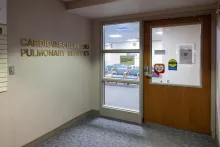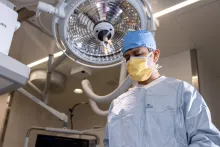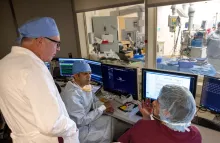Pacemaker
- For all other requests:
- 1-800-777-8442
If you have a cardiovascular condition such as an irregular heartbeat (arrhythmia) or heart failure, your provider may recommend a pacemaker to improve symptoms, restore your heart’s rhythm, or help your heart pump blood more efficiently to your body.
A pacemaker is a small device that is surgically placed inside your chest or abdomen to help regulate your heart’s electrical system. When your heart begins to beat slowly or has pauses, the device sends an electrical impulse into your heart to correct it.
University of Iowa Health Care electrophysiologists are extensively trained and perform hundreds of pacemaker implants every year. We are deeply familiar with these devices and know how to perform these procedures safely and successfully. We are also qualified to troubleshoot problems and answer any questions to help you make decisions about these devices with confidence.
Our approach to pacemakers
We use the most up to date technology that lets us monitor your pacemaker while you go about your day. The device automatically alerts us if you experience unusual changes in heart rhythm. This remote monitoring reduces the number of in-person device checks you’ll need throughout the year and allows us to quickly evaluate your heart at the first sign of abnormal symptoms.
We also provide innovative biventricular pacemakers (also known as cardiac resynchronization therapy device) to patients who have arrhythmia along with certain types of heart failure. These devices help restore the heart’s pumping ability, even among patients who might otherwise need a heart transplant.
Traditionally, pacemaker wires were screwed into the heart muscle, but research has shown that pacing the lower chambers of the heart using this technique can cause the heart muscle to become weak. Our electrophysiologists are experts at a new technique, conduction system pacing. This approach implants the wires into the natural wiring system of the heart, which allows the heart muscle to squeeze as naturally as possible and prevents weakening of the heart muscle. This novel way of pacing requires expertise and special techniques that our physicians teach other physicians around the world.
Types of pacemakers
We offer four types of pacemakers depending on your diagnosis. These include:
- Single-chamber pacemaker: This type of pacemaker has one lead (wire). It sends electrical impulses into one of your heart’s chambers, usually the right ventricle. This is sometimes referred to as single-chamber pacing.
- Dual-chamber pacemaker: This device has two leads that connect to both chambers on the right side of your heart—the right atrium and right ventricle. You may need this type of pacemaker if your right atrium and right ventricle aren’t pumping in sync.
- Biventricular pacemaker: This device, which treats arrhythmia and some types of heart failure at the same time, has three leads. It’s also known as cardiac resynchronization therapy (CRT) or a CRT-P device. It sends electrical impulses into your right atrium and both of your heart’s bottom chambers—the left and right ventricles. Because this helps the bottom chambers work together, your heart pumps blood more efficiently. This helps reduce heart failure symptoms and may even reverse heart muscle weakness (cardiomyopathy).
- Leadless pacemaker: A leadless pacemaker doesn’t have any leads. It’s implanted directly into your heart’s right ventricle. You may be eligible for this tiny pacemaker if you have a slow heart rate and only need single-chamber pacing.
What to expect when you receive a pacemaker
Pacemaker placement is a surgical procedure and usually takes a few hours to perform.
Your device placement will take place in our state-of-the-art cardiac catheterization lab.
Here’s what you can expect:
- You’ll probably only need light sedation, which keeps you awake but comfortable. If you or your provider thinks you should have general anesthesia instead, so you’re fully asleep, we'll discuss this with you beforehand.
- For pacemakers that have leads, we’ll guide them into your heart through your blood vessels. This requires a small incision near your collarbone. Then we’ll place the pulse generator underneath the skin on your chest and connect it to the leads. This usually requires a two- to three-inch incision (and local anesthetic to numb the skin).
- For leadless pacemakers, we use a flexible tube (catheter) to guide the device through your blood vessels and into your heart. This usually requires a tiny incision in your groin.
Your provider will let you know if you can return home the same day as your procedure or if you’ll need to stay overnight for observation.
Once your pacemaker is in place, you’ll need to keep a few things in mind:
- Be aware of any electrical or magnetic interference that could disrupt your device. For example, you may not be able to have MRI scans, and you should hold your cell phone at least six inches away from your device. Your provider will give you a complete list of equipment to avoid and guidelines to follow.
- If we’re monitoring your device remotely and it continues working properly, you only need an in-person check-up once each year.
- You may still need to take certain heart medications after you receive your device. A pacemaker alone can’t improve high cholesterol or high blood pressure.
- Depending on which type of pacemaker you have, the battery should last anywhere from five to 15 years. When it’s time to replace the battery, you’ll undergo a minor surgical procedure.
You should quickly see an improvement in your arrhythmia or heart failure symptoms, so you feel and function more like your old self.
Who can benefit from receiving a pacemaker?
As part of your treatment plan, a pacemaker can help manage symptoms and provide relief if you have one of the following conditions:
- Angina
- Heart palpitations
- Dizziness, lightheadedness, or fainting
- Tachycardia (an arrhythmia that causes rapid heartbeat)
- Bradycardia (an arrhythmia that causes slow heartbeat)
- Other arrhythmias (irregular heartbeats causes by skipping or adding a beat)
There may be other reasons your provider may recommend a pacemaker. Please talk to your provider if you have questions or think a pacemaker might be right for you.
Our Care Team










- Cardiothoracic Surgery
- Heart and Vascular



- Heart and Vascular


- Heart and Vascular

Not sure whether a pacemaker is right for you?
Locations and Offices







